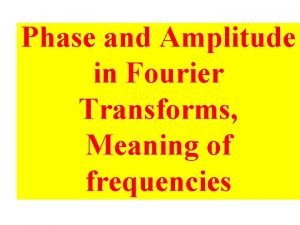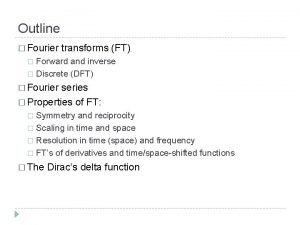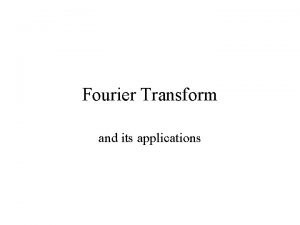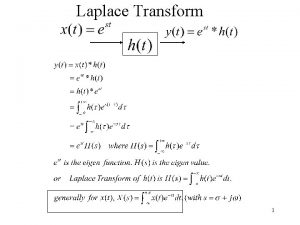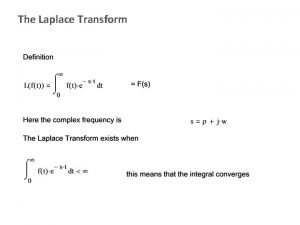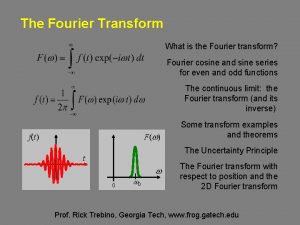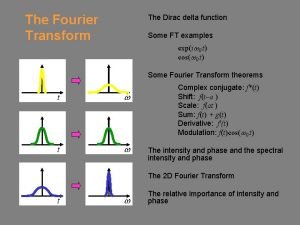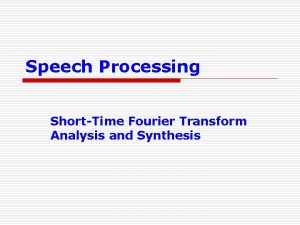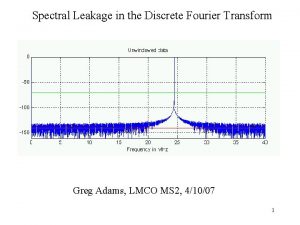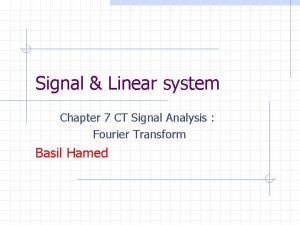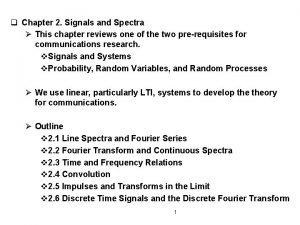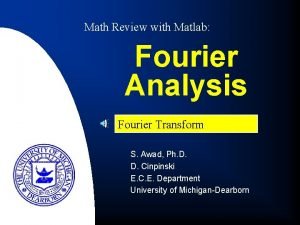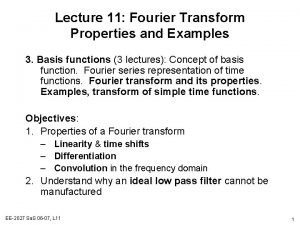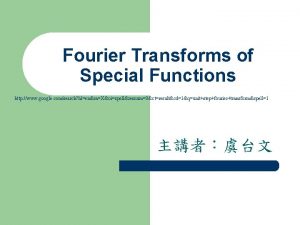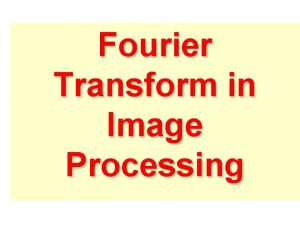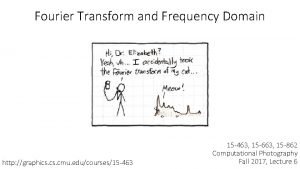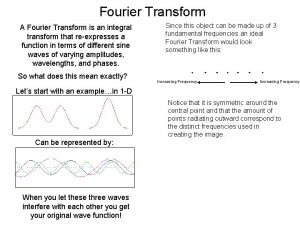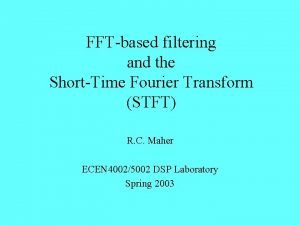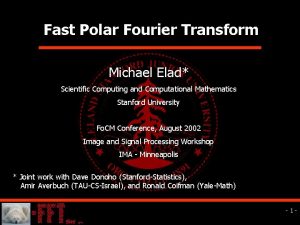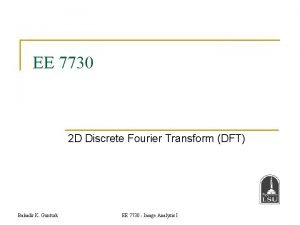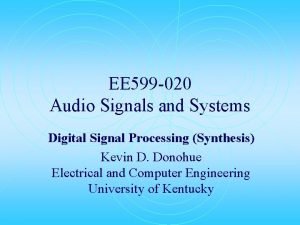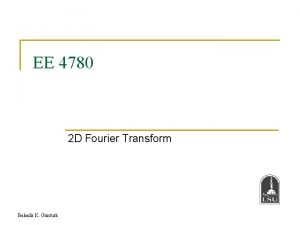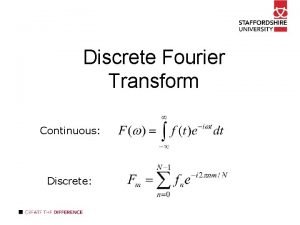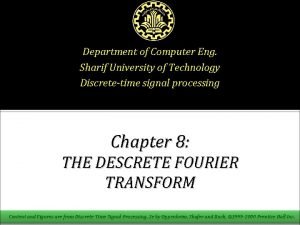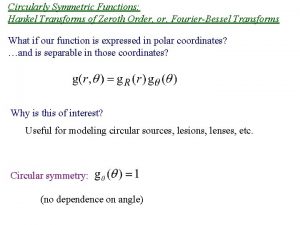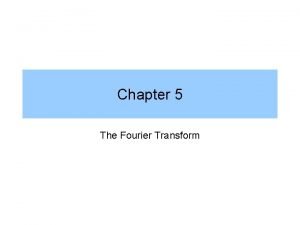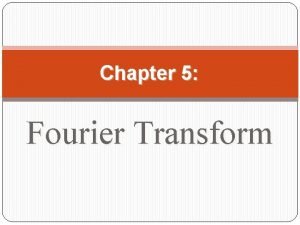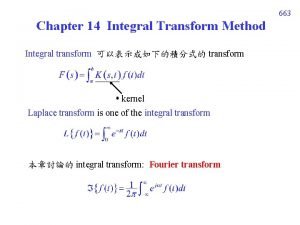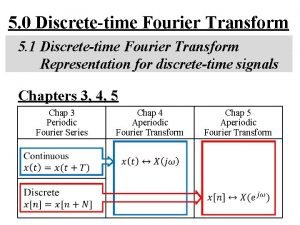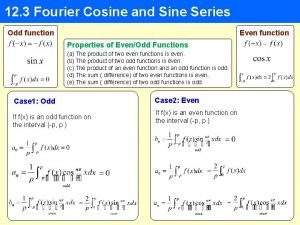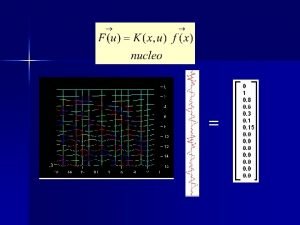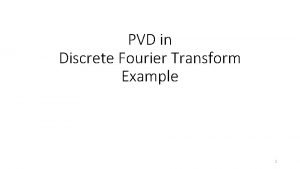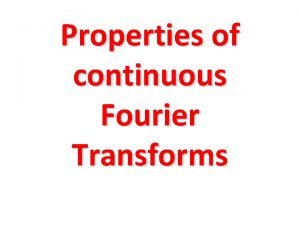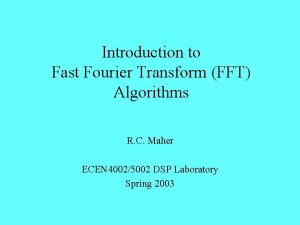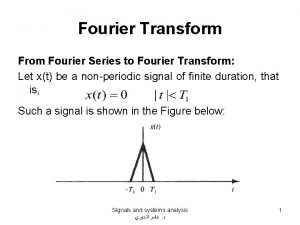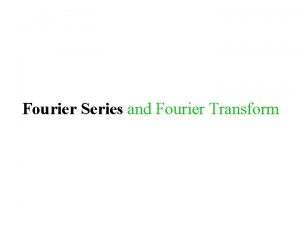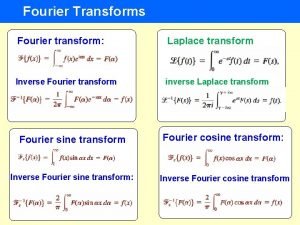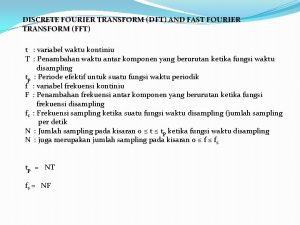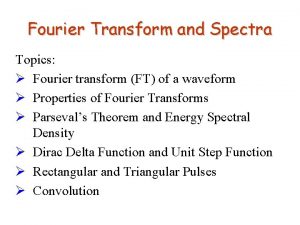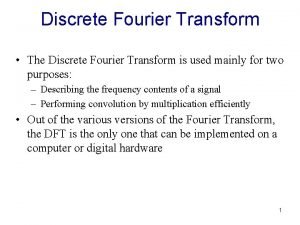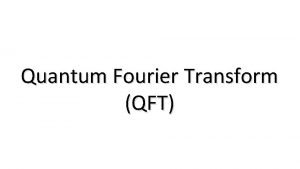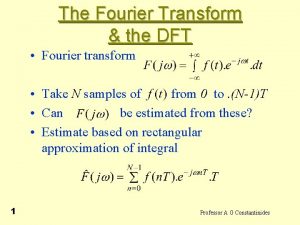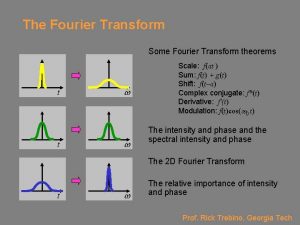Fourier Series and Fourier Transform The Fourier Series












































- Slides: 44

Fourier Series and Fourier Transform

The Fourier Series I/P Linear Circuit Sinusoidal Inputs O/P OK Nonsinusoidal Inputs Sinusoidal Inputs Fourier Series

The Fourier Series Joseph Fourier 1768 to 1830 Fourier studied the mathematical theory of heat conduction. He established the partial differential equation governing heat diffusion and solved it by using infinite series of trigonometric functions.

The Fourier Series Fourier proposed in 1807 A periodic waveform f(t) could be broken down into an infinite series of simple sinusoids which, when added together, would construct the exact form of the original waveform. Consider the periodic function T = Period, the smallest value of T that satisfies the above Equation.

The Fourier Series The expression for a Fourier Series is and Or, alternative form Fourier Series = a finite sum of harmonically related sinusoids

The Fourier Series is the average (or DC) value of f(t) For n = 1 the corresponding sinusoid is called the fundamental For n = k the corresponding sinusoid is called the kth harmonic term Similarly, w 0 is call the fundamental frequency kw 0 is called the kth harmonic frequency

The Fourier Series Definition A Fourier Series is an accurate representation of a periodic signal and consists of the sum of sinusoids at the fundamental and harmonic frequencies. The waveform f(t) depends on the amplitude and phase of every harmonic components, and we can generate any non-sinusoidal waveform by an appropriate combination of sinusoidal functions. http: //archives. math. utk. edu/topics/fourier. Analysis. html

The Fourier Series To be described by the Fourier Series the waveform f(t) must satisfy the following mathematical properties: 1. f(t) is a single-value function except at possibly a finite number of points. 2. The integral for any t 0. 3. f(t) has a finite number of discontinuities within the period T. 4. f(t) has a finite number of maxima and minima within the period T. In practice, f(t) = v(t) or i(t) so the above 4 conditions are always satisfied.

The Fourier Series Recall from calculus that sinusoids whose frequencies are integer multiples of some fundamental frequency f 0 = 1/T form an orthogonal set of functions. and

The Fourier Series The Fourier Trigonometric Coefficients can be obtained from average value over one period n>0

The Fourier Series To obtain ak The only nonzero term is for n = k Similar approach can be used to obtain bk

Example 15. 3 -1 determine Fourier Series and plot for N = 7 average or DC value

Example 15. 3 -1(cont. ) An even function exhibits symmetry around the vertical axis at t = 0 so that f(t) = f(-t). Determine only an

Example 15. 3 -1(cont. ) and where

Symmetry of the Function Four types 1. 2. 3. 4. Even-function symmetry Odd-function symmetry Half-wave symmetry Quarter-wave symmetry Even function All bn = 0

Symmetry of the Function Odd function All an = 0 Half-wave symmetry an and bn = 0 for even values of n and a 0 = 0

Symmetry of the Function Quarter-wave symmetry Odd & Quarter-wave All an = 0 and bn = 0 for even values of n and a 0 = 0

Symmetry of the Function For Even & Quarter-wave All bn = 0 and an = 0 for even values of n and a 0 = 0 Table 15. 4 -1 gives a summary of Fourier coefficients and symmetry.

Example 15. 4 -1 determine Fourier Series and N = ? 0 To obtain the most advantages form of symmetry, we choose t 1 = 0 s Odd & Quarter-wave All an = 0 and bn = 0 for even values of n and a 0 = 0

Example 15. 4 -1(cont. )

Example 15. 4 -1(cont. ) The Fourier Series is The first 4 terms (upto and including N = 7) Next harmonic is for N = 9 which has magnitude 3. 24/81 = 0. 04 < 2 % of b 1 ( = 3. 24) Therefore the first 4 terms (including N = 7) is enough for the desired approximation

Exponential Form of the Fourier Series is the average (or DC) value of f(t) and where and

Exponential Form of the Fourier Series or Writing Euler’s identity with in exponential form using where the complex coefficients are defined as And ; the coefficients for negative n are the complex conjugates of the coefficients for positive n

Example 15. 5 -1 determine complex Fourier Series Even function The average value of f(t) is zero We select and define

Example 15. 5 -1(cont. )

Example 15. 5 -1(cont. ) Since f(t) is even function, all Cn are real and = 0 for n even For n = 1 For n = 2 For n = 3

Example 15. 5 -1(cont. ) The complex Fourier Series is where For real f(t)

Example 15. 5 -2 determine complex Fourier Series Even function Use

Example 15. 5 -2(cont. ) To find C 0

The Fourier Spectrum The complex Fourier coefficients Amplitude spectrum Phase spectrum

The Fourier Spectrum is a graphical display of the amplitude and phase of the complex Fourier coeff. at the fundamental and harmonic frequencies. Example A periodic sequence of pulses each of width

The Fourier Spectrum The Fourier coefficients are For

The Fourier Spectrum where For

The Fourier Spectrum

The Truncated Fourier Series A practical calculation of the Fourier series requires that we truncate the series to a finite number of terms. The error for N terms is We use the mean-square error (MSE) defined as MSE is minimum when Cn = Fourier series’ coefficients

The Truncated Fourier Series overshoot

Circuits and Fourier Series It is often desired to determine the response of a circuit excited by a periodic signal v. S(t). Example 15. 8 -1 An RC Circuit v. O(t) = ? Example 15. 3 -1 An RC circuit excited by a periodic voltage v. S(t).

Circuits and Fourier Series Each voltage source is a term of the Fourier series of vs(f). An equivalent circuit.

Example 15. 8 -1 (cont. ) Each input is a Sinusoid. Using phasors to find steady-state responses to the sinusoids.

Example 15. 8 -1 (cont. ) where The first 4 terms of v. S(t) is The steady state response v. O(t) can then be found using superposition.

Example 15. 8 -1 (cont. ) The impedance of the capacitor is We can find

Example 15. 8 -1 (cont. ) The steady-state response can be written as In this example we have

Example 15. 8 -1 (cont. )

Summary The Fourier Series Symmetry of the Function Exponential Form of the Fourier Series The Fourier Spectrum The Truncated Fourier Series Circuits and Fourier Series
 Fourier transform amplitude and phase
Fourier transform amplitude and phase Inverse discrete fourier transform
Inverse discrete fourier transform The fourier transform and its applications
The fourier transform and its applications Relation between laplace and fourier transform
Relation between laplace and fourier transform Laplace formulas
Laplace formulas Inverse fourier transform
Inverse fourier transform Fourier transform of shifted delta function
Fourier transform of shifted delta function Ctft properties
Ctft properties Short time fft
Short time fft Dft table
Dft table Parseval's identity for fourier transform
Parseval's identity for fourier transform Duality of fourier transform
Duality of fourier transform Pulse train fourier transform
Pulse train fourier transform Fourier transform of ramp function
Fourier transform of ramp function Fourier transform mri
Fourier transform mri Fourier transform properties solved examples
Fourier transform properties solved examples Step function fourier transform
Step function fourier transform Fourier transform gaussian
Fourier transform gaussian Fourier transform of 1
Fourier transform of 1 Equation for fourier transform
Equation for fourier transform Math review
Math review Fourier transform of sin(2*pi*f*t)
Fourier transform of sin(2*pi*f*t) Fourier transform formula
Fourier transform formula Fourier transform of an integral
Fourier transform of an integral Stft
Stft Fourier transform in polar coordinates
Fourier transform in polar coordinates Fourier transform of product of two functions
Fourier transform of product of two functions 2d discrete fourier transform
2d discrete fourier transform Sinc fourier transform
Sinc fourier transform Fourier transform of impulse train
Fourier transform of impulse train Discrete fourier transform
Discrete fourier transform Overlap save method
Overlap save method Circ function fourier transform
Circ function fourier transform Duality of fourier transform
Duality of fourier transform Fourier transform is defined for
Fourier transform is defined for Fourier series formula
Fourier series formula Fourier transform
Fourier transform Fourier transform formula table
Fourier transform formula table Fourier integral representation
Fourier integral representation Duality of fourier transform
Duality of fourier transform Fourier sine and cosine series examples
Fourier sine and cosine series examples Windowed fourier transform
Windowed fourier transform Fourier transform
Fourier transform Integration of delta function
Integration of delta function Introduction to fast fourier transform
Introduction to fast fourier transform
